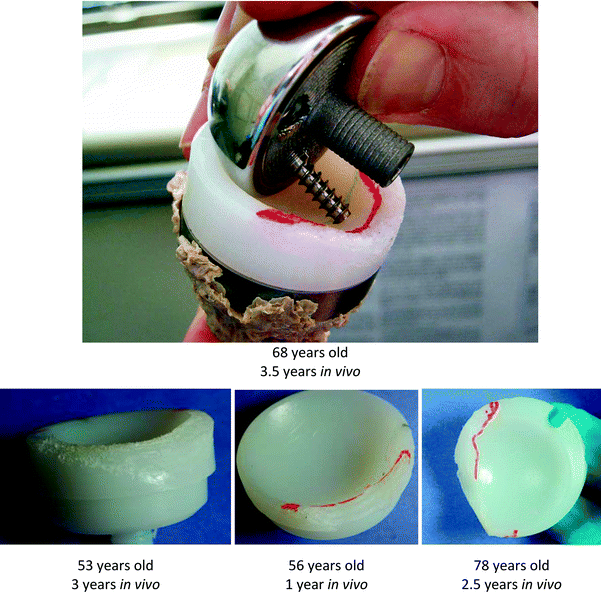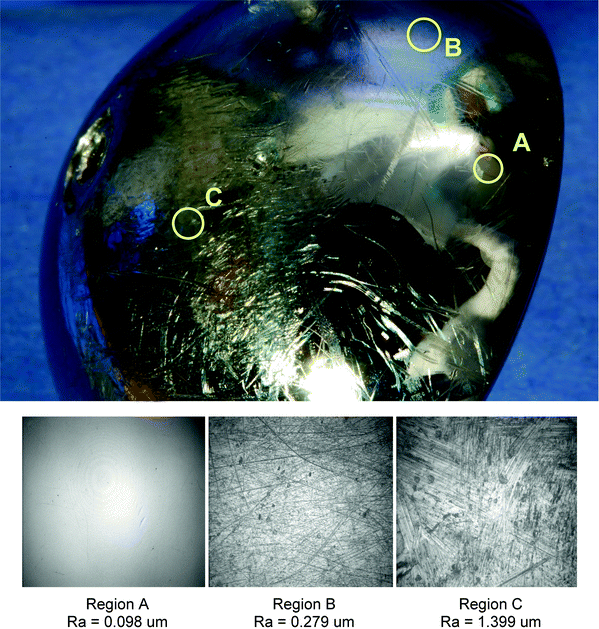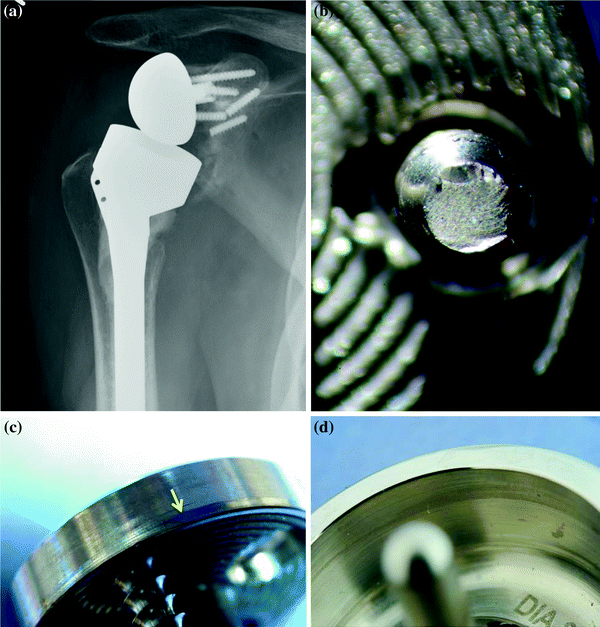Fig. 12.1
Examples demonstrating bearing surface wear. MicroCT data (green) were registered with an idealized head (orange) for all of the retrievals. Estimated regions of wear are represented by a gap between the idealized head and the measured surface. Polyethylene damage was predominantly due to rim damage. Evidence of rim damage was clearly visible on the renderings

Fig. 12.2
Humeral bushings demonstrating rim damage due to contact with scapular bone and/or screws
Our observation of minimal bearing surface wear is not consistent with previous predictions that reverse total shoulder replacement designs would produce greater amounts of polyethylene wear at the bearing surface than their anatomic counterparts [15]. However, further long-term follow-up including well-functioning RSAs, and quantitative analysis of both anatomic and reverse total shoulders will be necessary to provide a definitive answer to this question. Further, it is currently unknown whether differing particle morphologies between the anatomic and reverse shoulders could affect the incidence of osteolysis and loosening.
A frequent and potentially concerning phenomenon of reverse shoulder arthroplasty is the appearance of scapular notching, often present on follow-up radiographs. Scapular notching defines an area of bone loss, typically on the inferior neck of the scapula that is typically thought to be the result of mechanical impingement between the polyethylene and the scapula [16–18]. However, more severe grades of scapular notching are thought to occur via two processes: (1) the mechanical impingement described above in concert with (2) an osteolytic reaction brought on by the presence of polyethylene wear debris within the joint space [16–21]. Our results demonstrate that mechanical impingement is present in patients undergoing revision surgery, many of whom exhibited radiographic scapular notching. While the clinical significance and prevalence of impingement in well-functioning RSA remain unclear, it is of potential concern because the impingement destroys bone as well as generates polyethylene wear debris.
Glenosphere Damage
Similar to the bearing surfaces of other orthopedic devices, the glenosphere of a RSA is manufactured with a highly polished surface. Polishing of the cobalt chrome surface creates beneficial tribological conditions and reduced wear of the polyethylene counterface. However, as has been demonstrated in total hips and knees, roughening of the metal bearing surface can occur in vivo [22–26]. This can occur due to scratching of the metal bearing surface by third-body particles such as bone debris, radiopacifiers in bone cement, or metal debris which become embedded in the polyethylene counterface surface [25–27]. Roughening of both ceramic and metal femoral heads has also been demonstrated in the hip, as the result of unintentional contact with the acetabular shell during dislocation events [28, 29]. This may also be a source of glenosphere damage in RSAs complicated by instability. Although some retrieval studies have failed to demonstrate a statistically significant relationship between roughness of the metal component and in vivo wear, multiple studies have demonstrated either increased wear or potential for wear in association with roughened components [23, 26, 30–32].
We have observed prevalent scratching and roughening of the retrieved glenospheres in our collection. This ranged from light scratching of the surface after short-term implantation to substantial focal damage, particularly in patients with instability. We observed both the presence of third-body particles embedded in the polyethylene bearing surface and evidence of unintentional (mode II) contact between the humeral component and the glenosphere. The resulting roughness can be quantified using white-light interferometry. An example of a glenosphere from an unstable shoulder is included in Fig. 12.3 demonstrating regions with focal damage, light scratching, and other areas with little or no damage.


Fig. 12.3
Retrieved glenosphere implanted in a 53-year-old male with rotator cuff insufficiency and revised after 3 years for instability. Three distinct regions of damage were noted: (A) those with minimal damage of the original surface finish, (B) dull areas with dense light scratching, and (C) a focal region of severe surface damage. Damage of the glenosphere, often extreme, was often noted in reverse shoulders revised for instability
The long-term consequences of glenosphere roughening after reverse shoulder arthroplasty remain unclear. Although accelerated polyethylene wear has been reported in association with third-body debris and head roughening in the hip, we have seen little evidence demonstrating significant bearing surface wear at short- to medium-term RSA retrievals. In cases of unstable shoulders, the degree of roughening observed was similar to the most extreme cases observed in hips with a history of dislocation [28, 29] where it has been reported that surface roughening was associated with a doubling of the polyethylene wear rate [28].
Modularity and Corrosion
Modularity of orthopedic components enables flexibility of designs and can allow for more precise patient-specific fitting of implants. However, taper corrosion was identified as a clinical concern soon after the introduction of modular heads in total hip arthroplasty in the 1980s and 1990s. Taper corrosion has been characterized as mechanically assisted crevice corrosion [33, 34]. During this process, mechanical fretting and wear contribute to the disruption of protective oxide layers on the surface of the taper. As the surface repassifies, the voltage of the metal surface is altered resulting in the acidification of the fluid within the taper junction and increasing the potential for crevice corrosion to occur [33–35]. As a result, taper corrosion is affected by a complex interplay of metallurgical, chemical, electrical, tribological, design, and patient-related factors [36].
We examined the taper junctions of our retrieved components for evidence of fretting and/or corrosion (i.e., tribocorrosion). Taper junctions were scored visually using a modified Goldberg method [35]. This method was developed during a multicenter retrieval investigation of taper corrosion of the stem/head junction in historic hips and demonstrated that metallurgy, implantation time, and flexural rigidity of the femoral neck were predictors of corrosion of the neck and head. In the modified method, the taper junction is assessed visually and microscopically and a score is assigned based on the extent of fretting and corrosion observed (Table 12.1). Recent studies employing a similar method have investigated taper corrosion in retrieved knees, modular necks, and shells and ceramic heads [36–38].
Table 12.1
Modified Goldberg score used for visual scoring
Damage | Score | Criteria |
|---|---|---|
Minimal | 1 | Fretting on <10 % of the surface and no corrosion damage |
Mild | 2 | Fretting on >10 % of the surface and/or corrosion attack confined to one or more small areas |
Moderate | 3 | Fretting on >30 % of the surface and/or aggressive local corrosion attack with corrosion debris |
Severe | 4 | Damage over the majority (>50 %) of the surface with severe corrosion attack and abundant corrosion debris |
In our RSA cohort, there was minimal to mild damage for the majority of the modular connections. When damage was observed, it was generally limited to fretting with little or no corrosion. Mild to moderate fretting was commonly observed at the interface between the glenosphere and metaglene (Fig. 12.4). Extreme fretting damage of this junction was observed in one implant that was revised after 3.3 years for catastrophic loosening, infection, and fracture of a glenoid screw.


Fig. 12.4
Retrieved metaglene and glenosphere implanted in a 77 year old revised after 0.5 years for humeral and glenoid loosening. Screw fracture was consistent with fatigue (top right). Damage of the modular junction consisted of mild to moderate fretting of the metaglene with limited damage of the opposing surface of the glenosphere. There was little or no evidence of corrosion. This damage pattern was common within our collection. a Radiograph. b Fractured screw. c Metaglene. d Glenosphere
Our observation of damage limited to fretting in the absence of corrosive attack in modular shoulders is not consistent with observations in retrieved total hips and knees where corrosion of the taper junction is commonly observed [35–37]. Whether this observation is due to the limited implantation times for the implants in our collection or to the specific characteristics of RSA is currently unknown.
Stay updated, free articles. Join our Telegram channel

Full access? Get Clinical Tree








